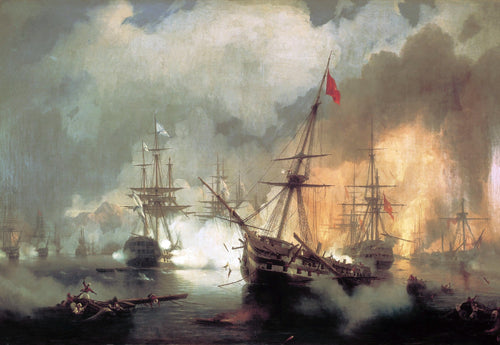The Battle of Navarino, fought on October 20, 1827, was a pivotal naval engagement during the Greek War of Independence. This battle involved a combined British, French, and Russian fleet confronting the Ottoman and Egyptian fleet in the bay of Navarino, located in the southwestern region of the Peloponnese in Greece. The battle resulted in a decisive victory for the allied European forces, contributing significantly to the eventual independence of Greece from Ottoman rule.
Background:
The Greek War of Independence began in 1821, with the aim of liberating Greece from more than 400 years of Ottoman domination. Throughout the conflict, various European powers sympathized with the Greek cause, but they remained hesitant to intervene directly. However, by 1827, the escalating violence and the possibility of Russian intervention led Britain, France, and Russia to form an alliance to force a diplomatic resolution to the conflict.

(Painting by Ambroise Louis Garneray (1783–1857)
The Fleets:
Allied European Fleet:
The combined British, French, and Russian fleet was under the command of British Admiral Sir Edward Codrington. The fleet consisted of 27 ships, including 10 British, 7 French, and 10 Russian vessels. Their primary objective was to enforce the Treaty of London, which called for a ceasefire between the Ottoman Empire and the Greek rebels.
Ottoman-Egyptian Fleet:
The Ottoman-Egyptian fleet was led by Ibrahim Pasha, the son of Egypt's ruler, Muhammad Ali Pasha. The fleet consisted of 78 ships, including both warships and transport vessels, with the purpose of suppressing the Greek rebellion and re-establishing Ottoman control over the region.
The Battle:
On October 20, 1827, the European allied fleet entered the bay of Navarino and approached the anchored Ottoman-Egyptian fleet. As negotiations between the two sides stalled, tensions escalated, and a stray shot from an Ottoman ship ignited the powder keg.
The battle quickly turned into a one-sided affair, with the superior firepower and discipline of the European fleet overwhelming the Ottoman and Egyptian forces. Within hours, the majority of the Ottoman-Egyptian fleet was either sunk or crippled, with minimal losses for the allied European forces.
(Painting by Thomas Luny (1759–1837) - Buy Print
Aftermath and Legacy:
The Battle of Navarino was a crucial turning point in the Greek War of Independence. The destruction of the Ottoman-Egyptian fleet effectively ended Ottoman attempts to suppress the Greek rebellion by force. The outcome of the battle also spurred the European powers to increase their support for the Greek cause, ultimately leading to the Treaty of Constantinople in 1832, which recognized the independence of Greece.
While the battle was celebrated as a triumph in Greece and the allied European nations, it also strained diplomatic relations between the European powers and the Ottoman Empire. The battle is considered one of the last major engagements involving sailing warships before the advent of steam-powered vessels.
In conclusion, the Battle of Navarino stands as a testament to the bravery and determination of those who fought for Greek independence. As a key turning point in the Greek War of Independence, the battle continues to be remembered as a pivotal moment in Greek history and a symbol of the enduring struggle for freedom and self-determination.











